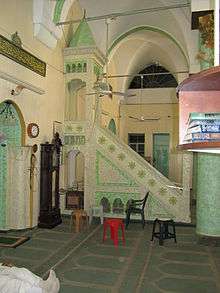Hanbali Mosque
The Hanbali Mosque (also known as Hanabila Mosque) is a major mosque in central Nablus off Jama'a Kabir Street south of Martyr's Square and west of the Great Mosque of Nablus.[1]
| Hanbali Mosque Jama'a al-Hanabila | |
|---|---|
 The minbar inside the Hanbali Mosque | |
| Religion | |
| Affiliation | Islam |
| District | Nablus Governorate |
| Status | Active |
| Location | |
| Location | |
| Architecture | |
| Type | Mosque |
| Style | Ottoman |
| Completed | 16th-century |
| Minaret(s) | 1 |
History
The Hanbali Mosque was founded by the al-Hanbali family of Nablus in the early 16th-century, between 1526-27,[2] and named after them. Ancient stone pillars with carved capitals were used during the mosque's construction, possibly dating from the Byzantine or Roman eras.[3] According to local Muslim tradition, the wooden box in the mosque preserves three hairs of Muhammad, the prophet of Islam. The box is brought out annually on the 27th day of Ramadan for worshipers to view and seek blessings from.[4]
The minaret of the Hanbali Mosque was rebuilt in 1913.[2] In the 1930s the imam of the mosque, Sheikh Muhammad Radi al-Hanbali maintained connections with the rebel leader Izz al-Din al-Qassam. The Hanbali family administers the mosque's affairs until the present day.[5] During Jordanian rule in the West Bank following the 1948 Arab-Israeli War, it was one of the few mosques that maintained its own zakat committee which would control the collection and distribution of zakat funds throughout the local community.[6]
References
- Iriving, 2004, p. 212.
- Old City Historic Buildings Archived 2012-02-20 at the Wayback Machine. Nablus Website.
- Nofal, Aziza (29 June 2016). "Nablus' ancient mosques tell story of religions throughout history". Al Monitor. Archived from the original on 16 August 2016. Retrieved 14 August 2016.
- Irving, 2004, p. 220.
- Kedourie, p. 89.
- Schäublin, Emanuel. The West Bank Zakat Committees (1977–2009) in the Local Context Archived 2012-06-27 at the Wayback Machine. The Graduate Institute. Geneva, 2010. p. 15.
Bibliography
- Irving, Sarah (2012). Palestine. Bradt Travel Guides. ISBN 1841623679.
- Kedourie, Elie (1982). Zionism and Arabism in Palestine and Israel. Psychology Press. ISBN 0714631698.